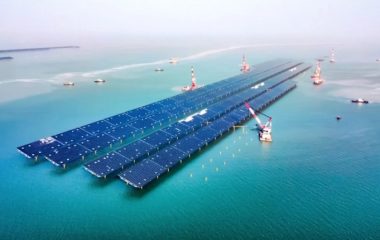
Photo: Recep Tayyip Erdoğan / Twitter screenshot
The General Directorate of State Hydraulic Works – DSI has finished the 558 MW Yusufeli hydropower plant and arch dam, the fifth-highest in its class in the world.
The Çoruh river in northeastern Turkey is now filling the reservoir at the Yusufeli dam, which is 275 meters high from the foundation. The works on one of the government’s main infrastructure projects started almost ten years ago. The structure can store a total of 2.13 billion cubic meters of water.
The arch dam, the fifth-highest in its class on the planet, includes a hydropower plant with 558 MW in machine capacity. It consists of three Francis-type turbines, each with a 180 MW connection.
Yusufeli to bolster downstream hydropower plants
President Recep Tayyip Erdoğan claimed the system would contribute TRY 5 billion (EUR 256 million at the current exchange rate) in added value to the country’s economy. Officials added that it would meet the electricity demand of 2.5 million residents.
The projected annual output at Yusufeli hydropower plant is equivalent to the power consumption of 2.5 million people in Turkey
The Yusufeli hydropower plant’s annual output is estimated at 1.9 TWh. It is set to boost the production of hydropower plants downstream in the basin by 10%, when it is commissioned.
DSI transplanted almost 6,000 fruit trees
The project, including a settlement for the people that were displaced, 46 tunnels and 23 bridges and viaducts, cost TRY 34 billion (EUR 1.75 billion).
The new power plant accounts for 1.7% of Turkey’s installed hydroelectric capacity
State-owned General Directorate of State Hydraulic Works – DSI, which conducted the works, also moved 5,844 fruit trees, mostly olives, mulberries, walnuts and pomegranates. Furthermore, it planted another 77,000 trees.
The power plant accounts for 1.7% of the country’s installed hydroelectric capacity, Minister of Energy and Natural Resources Fatih Dönmez said. Turkey has 750 hydropower plants, he added. They account for 20% of total electricity output. Çoruh is the fastest-flowing river in Turkey.


















3 x 180 = 540, NOT 558. Are there any small turbine-generatio0n sets to supply electricity just for the dam site??? If their total hydro.cap. is 750 MW, then 558 is almost 75 % of that total , not 1.7%!!!. Hire 2 “Proof-Thinkers”!!! Re-Take 3rd grade arithmetic.